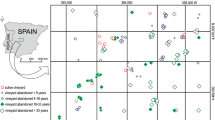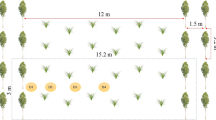Abstract
In the central highlands of Mexico, heavily eroded soils are often colonized by catclaw (Mimosa buincifiera): an N2-fixing shrub. An experiment was carried out to investigate how this shrub affected characteristics of the soil and its biological functioning. Soil was sampled from outside and under the canopy of catclaw at three sites characterized by different degrees of erosion and an increase in plant density. The soil microbial biomass C, total amounts of bacteria, fungi, actinomycetes and free-living N2-fixing micro-organisms were measured, while production of CO2 and dynamics of nitrate (NO3 –), nitrite (NO2 –) and ammonium (NH4 +) were monitored in an aerobic incubation at 22±1 °C for 35 days. The C content was 1.6 times greater in the area with the largest density of plants and the least erosion (RECUP) compared with the site with the lowest density and greatest erosion (DEGR), while it was 1.2 times greater under the canopy of the catclaw than outside it (average of the three sites). The incorporation of N into the soil organic matter was greater under the canopy of the catclaw than outside it as the C:N ratio was on average 8.4 and 9. 1, respectively. The microbial biomass C, as a percentage of soil organic matter, was 1.5 times greater in the RECUP than in the DEGR site. Greatest total number of colony-forming bacteria and fungi (mean of organisms found under and outside the canopy) were found in the RECUP treatment and lowest in the DEGR treatment. Free-living N2-fixing organisms and actinomycetes showed opposite trends. Greater total numbers of colony-forming bacteria, fungi, actinomycetes and free-living N2-fixing organisms (mean of the three treatments) were found under the canopy of catclaw than outside of it, Production of CO2 was 1.8 times greater in the RECUP than in the DEGR and 1.6 times greater under the canopy of catclaw than outside. Production of NO3 – was 1.3 times greater in the RECUP than in the DEGR and 3.5 times greater under the canopy of catclaw than outside. There was no significant effect of location or canopy on NO2 – and NH4 + concentrations. It is concluded that the natural vegetation of catclaw increased microbial biomass and soil organic matter content under, but also outside its canopy, and preserved N better, releasing greater amounts of inorganic N upon mineralization. Catclaw can serve as a first colonizer of heavily eroded soil and be replaced by other vegetation, natural or crops, when fertility is restored.
Similar content being viewed by others
Author information
Authors and Affiliations
Additional information
Received: 4 November 1999
Rights and permissions
About this article
Cite this article
Luna-Suárez, S., Frias-Hernández, J., Olalde-Portugal, V. et al. Catclaw (Mimosa buincifiera): a pest or a means to restore soil fertility in heavily eroded soil from the central highlands of Mexico?. Biol Fertil Soils 32, 109–113 (2000). https://doi.org/10.1007/s003740000224
Issue Date:
DOI: https://doi.org/10.1007/s003740000224




